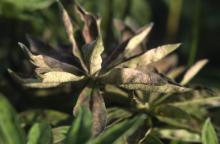Cause The fungus-like organism Peronospora trifoliorum has been reported in all PNW states. Although downy mildew of alfalfa is attributed to the same organism, it is unlikely that an alfalfa isolate will infect lupine. This organism is favored by wet, rainy conditions in spring and generally is a problem only in gardens.
Symptoms On Lupinus polyphyllus 'Russell Strain' severely infected leaves turn purple and curl down. A whitish to gray growth may develop on the leaf underside. Leaves are stunted and eventually die. Leaves may become dry and crumbly when hot weather prevails.
Cultural control
- Purchase clean stock.
- Do not water from overhead, or adjust irrigation so plants are not wet for extended periods.
- Space plants for good air circulation.
- Remove and destroy infected plant debris.
- Maintain adequate fertility.
Chemical control Alternate or tank-mix products from different groups that have different modes of action.
Ornamental materials:
- Compass 50 WDG at 1 to 2 oz/100 gal water can be used. Do not use organosilicate additives. Group 11 fungicide. 12-hr reentry.
- Phyton 27 at 1.5 to 3 oz/10 gal water. Group M1 fungicide. 48-hr reentry.
- Insignia at SC 3 to 6 fl oz/100 gal water. Do not use with organosilicate-based adjuvants. Use preventively only. Group 11 fungicide. 12-hr reentry.
- Segovis at 0.6 to 3.2 fl oz/100 gal water plus another fungicide. Group 49 fungicide. 4-hr reentry.
- Although not specifically registered for lupine, products such as Heritage are safe on this crop, according to IR-4 data, and may be of some benefit. Group 11 fungicide. 4-hr reentry.
Field Crop materials:
- Headline at 6 to 9 fl oz/A. Preharvest interval is 21 days. 12-hr reentry.


